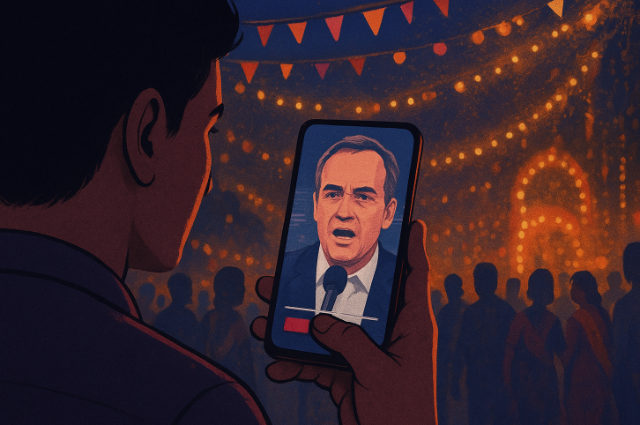
The digital age, the battleground of politics has moved far beyond rallies, manifestos, or even the 24/7 news cycle. Today, one of the most insidious weapons in the arsenal of political actors is Deepfakes, a type of synthetic media, generated by artificial intelligence, that can manipulate audio and video to make people appear to say or do things they never did. Nowhere is the psychological impact of deepfakes more potent, or their deployment more strategic, than during major festival seasons. The question is not why, but how: what psychological and warfare dynamics explain the strategic peaking of political deepfakes during these festival periods.
To understand this phenomenon, we must first recognize the psychological landscape of festival seasons. Festivals are not just dates on a calendar; they are moments of heightened social energy, collective emotion, and renewed group identity. Whether it’s Diwali in India, Christmas in the United States, Ramadan in the Islamic world, or the Lunar New Year across Asia, festivals mark times when families gather, communities celebrate, and cultural narratives are reinforced. This communal atmosphere, filled with emotion and social interaction, creates a fertile ground for the propagation of information—both genuine and manufactured. First, festival seasons are periods of wide audience engagement. In our sense, they serve as lightning rods for public attention. People are more likely to be active on social media, sharing photos, and, crucially, news and videos. The sharing translates into a vastly increased reach for any piece of digital content. Pol. The goal is straightforward: maximize exposure and virility. When more people are online and emotionally present, the chances of a Deepfake going viral rise dramatically. This brings us to a second, more subtle form of psychological warfare: the information technology emotional vulnerability, and group psychology. Festivals of the powerful emotions joy, nostalgia, longing, pride, and sometimes give information about the grievance.
Political Deepfakes, which are digitally manipulated videos or images that appear to show real people saying or doing things they never did, are prevalent during festival season to explore the emotional state and increased media consumption typical of these periods. The festive atmosphere can make people more comfortable, to emotional appeals less critical. the thing makes information easier to manipulate, the normal people in society to be manipulated by fake deepfakes.
A particularly tactical aspect of Deepfakes proliferation during festivals relates to what psychologists and military theorists term "information fatigue" or "information overload." During high-attention periods, the volume of messages, advertisements, and celebratory posts skyrockets. They are, in essence, the digital heir to these wartime strategies, supercharged with the powers of modern technology.
Deepfakes could be used to spread false information about the economy or business during a festival, potentially causing panic about the economic fluctuations. The use of deepfakes is not merely a matter of technology. The psychological consequences for societies are profound and dangerous. Deepfakes could be used to spread false information about social movements or protests during festivals. Potentially protest the Deepfakes problem in our country during festival season, then the authenticity of visual evidence can no longer be trusted, and the very notion of truth becomes slippery. Annual rhythm of festival-based disinformation campaigns, and the unique vulnerabilities counteract the next wave of digital.
In summary, political deepfakes spike during festival seasons not by accident but by design. Due to the psychological vulnerability they exploit the strategic opportunities they present for misinformation actor understanding these dynamic These periods offer unprecedented opportunities for psychological manipulation: mass gatherings mean bigger audiences; emotional states run high, making people more suggestible; social tensions are laid bare and easily escalated; verification barriers rise in the deluge of holiday media; and strategic timing enables maximum disruption with minimum effort. Deepfakes are a psychological weapon, launched precisely when societies are at their most open, most connected, and paradoxically, most vulnerable. In the ongoing evolution of information technology.
The political deepfakes increase due to several reasons in political leaders and environmental issues. Festival seasons typically witness a spike in social media activity and public interaction, which leads to a boost in political deepfakes. People spend more time online exchanging news and videos, and are more laid back, which makes it ideal for deepfakes to proliferate. When the audience is very engaged but less critical, malicious actors take advantage of this and release AI-generated bogus videos to sway opinions, cause confusion, or change political narratives. Festivals are also prime opportunities for the dissemination of false information because they frequently fall during significant political events or election cycles. People are more susceptible to misleading content that takes advantage of political or cultural divisions while emotions are running high. Political deepfakes are produced by combining emotional connection with high online traffic.
Festival seasons are the height of political deepfakes because more people are online sharing content, which makes it easier for phoney films to proliferate. These deepfakes take advantage of the sentimental and joyous atmosphere, which makes it simpler to sway judgments or create confusion when people are less watchful.
